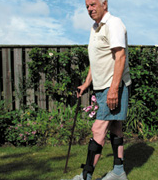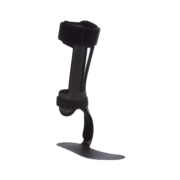Dropfoot Syndrome
Dropfoot Syndrome typically refers to a medical condition where a patient has trouble lifting their forefoot when walking. It is commonly called interchangeably as “drop foot” and “foot drop,” the condition presents itself as toe dragging when walking. If you notice when walking that you might be affected by this drop foot, consult with a trained medical professional as soon as possible.
In some cases, symptoms of dropfoot syndrome (or foot drop) can be the sign of a neurological disorder. The peroneal nerve in your leg may have become injured which is causing your dropfoot symptoms. This is the most common cause of this condition. Your peroneal nerve can be damaged or pinched as a result of a number of events including trauma, surgery, stroke, fractured shin, or even crossing your legs or squatting for an extended period of time.
However, other causes of the condition exist including multiple sclerosis (MS), amyotrophic lateral sclerosis (ALS) and Parkinson’s disease. Understanding the reason why you are experiencing these foot drop symptoms it is critical to resolving or treating the cause.
Signs of Dropfoot Syndrome
The early symptoms of dropfoot syndrome are usually somewhat subtle and some time may pass before you realize that something more serious is going on. However, one of the earliest signs that will alert you to the possibility that you have this condition is an inability to flex your foot upwards when you previously had no trouble doing so.
You may also notice that you seem to trip and fall a bit more often than in the past. This can be a result of your gradual loss of control of the fine movement of your feet. You may also notice that you have some difficulty with using your foot in a dextrous way in the course of your daily routine while using the gas and brake pedals of your car, for example.
How is Drop Foot Treated?
Treatment for this condition varies depending on the root cause of the symptoms and the extent to which the nerve damage has spread. Treatment options can include:
- Orthotics, such as braces and splints
- Functional Electrical Stimulation
- Physical Therapy
- Surgical Intervention
If you catch dropfoot syndrome early, the nerve could have a chance to heal itself. If this is the case, the use of orthotic devices like lightweight braces or shoe inserts can make a big difference for your comfort while the healing process is taking place. If the damage is more extensive, then physical therapy or even surgery may be recommended. However, exploring your treatment options should be done only in consultation with a trained medical professional or healthcare provider familiar with drop foot.
Recovery Outlook
The recovery outlook for dropout syndrome depends upon the extent of the damaged to your nerve. Catching dropfoot (or foot drop) early is vital as is seeking medical attention and proper orthopedic support in order to prevent the condition from getting worse. Make sure to do exercises to strengthen your feet and ankles. This can help to speed up the recovery process following surgery. Make your home safe for dropfoot syndrome. This means removing any tripping hazards!
If you find that your dropfoot symptoms cannot be completely resolved, you can still live a comfortable and issue-free life with effective orthopedic support. At Synergy Orthopedics, we are happy to find solutions in conjunction with your physician or healthcare provider that will allow you to return to the level of activity you used to enjoy before your dropfoot symptoms began.
If you have already been diagnosed withdropfoot and you are looking for top-notch orthopedic support to facilitate your recovery, contact the team at Synergy Orthopedics today.



